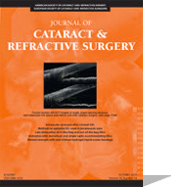 In the year 2000, the internationally acclaimed medical journal, Journal of Cataract and Refractive Surgery, published an exploratory article by Dr. Shapiro on Customized Wavefront LASIK. Dr. Shapiro became one of the first surgeons in the world to author an article on this breakthrough technology. Three years later, the FDA approved Customized Wavefront LASIK for the treatment of nearsightedness and astigmatism.
In the year 2000, the internationally acclaimed medical journal, Journal of Cataract and Refractive Surgery, published an exploratory article by Dr. Shapiro on Customized Wavefront LASIK. Dr. Shapiro became one of the first surgeons in the world to author an article on this breakthrough technology. Three years later, the FDA approved Customized Wavefront LASIK for the treatment of nearsightedness and astigmatism.
Since the time of FDA approval, Dr. Shapiro has been an international leader in guiding the clinical evolution of customized wavefront laser vision correction. Dr. Shapiro was the first surgeon in the world to publish about the use of customized wavefront LASIK to correct night vision problems from older, conventional LASIK surgery. This landmark paper opened up a new therapeutic role for wavefront surgery for patients with night vision problems who previously had no good treatment options. Dr. Shapiro was also the first surgeon in the world to describe the use of customized wavefront LASIK to improve optics after previoius conventional PRK surgery. Dr. Shapiro has also published the world’s first article describing the use of third generation wavefront technology in managing complex small pupil LASIK cases which could not be successfully treated even with earlier forms of wavefront surgery. Dr. Shapiro’s teaching articles on Customized Wavefront LASIK have been published worldwide.
TRADITIONAL APPROACH: CONVENTIONAL LASIK
Conventional (non-wavefront) LASIK, through such advances as three dimensional eye tracking and excimer lasers capable of billionth of an inch accuracy, has evolved over the years to offer outstanding results. When performed by an experienced surgeon with the best equipment, it is very common for patients undergoing the latest generation of conventional LASIK to see as well after surgery as they did with their glasses or contact lenses. In fact, conventional LASIK attempts to do exactly what glasses and contact lenses do, namely to fully correct one’s nearsightedness, farsightedness, and astigmatism. The goal of Customized Wavefront LASIK, however, ultimately is to go a step further and to provide vision even better than with glass or contacts.
RAISING THE BAR: CUSTOMIZED WAVEFRONT LASIK
 In May, 2003, the FDA first approved the use of the Customized Wavefront LASIK using the VISX CustomVue System, an entirely new generation of laser vision correction and the predecessor of the Customized Wavefront system used today by Dr. Shapiro. With CustomVue custom wavefront LASIK, the goal of surgery was no longer to equal the best glasses or contacts, but actually to exceed the quality of vision of glasses or contacts. The results of the FDA trials of this initial form of Customized Wavefront LASIK in 2003 were outstanding:
In May, 2003, the FDA first approved the use of the Customized Wavefront LASIK using the VISX CustomVue System, an entirely new generation of laser vision correction and the predecessor of the Customized Wavefront system used today by Dr. Shapiro. With CustomVue custom wavefront LASIK, the goal of surgery was no longer to equal the best glasses or contacts, but actually to exceed the quality of vision of glasses or contacts. The results of the FDA trials of this initial form of Customized Wavefront LASIK in 2003 were outstanding:
- 100% of patients could pass a driver’s test without glasses or contacts.
- 98% of patients saw 20/20 or better
- 70% actually ended up with vision better than 20/20.
- Four times as many patients were happy with their night vision after Customized Wavefront LASIK than were happy before surgery with their glasses or contact lenses.
- No one in the FDA study reported worse night vision after Custom Wavefront LASIK than with their glasses or contacts before surgery.
These were the best data ever recorded by the FDA for any form of LASIK. This data, as good as it is, reflects the original, first generation format of Customized Wavefront LASIK from 2003. Today, we are in the third generation of Customized Wavefront LASIK, which has made results even better. Dr. Shapiro considers third generation wavefront to be the mature form of the technology. Obviously, LASIK is still eye surgery and results of surgery can never be guaranteed, but this FDA data shows how successful a surgery even the first generation Customized Wavefront LASIK using the VISX CustomVue system was. Since 2003, years of evolution in Customized Wavefront surgery have made wavefront LASIK even better. In fact, in a study of third generation Customized Wavefront LASIK conducted at the Shapiro Laser Eye Center and presented at the international meeting of the Association for Research and Vision in Ophthalmology (ARVO), 96% of Dr. Shapiro’s patients reported vision actually better than with glasses or contact lenses — the other 4% reported vision equal to their glasses or contacts.
HOW CUSTOMIZED WAVEFRONT LASIK WORKS
Conventional LASIK Measurements
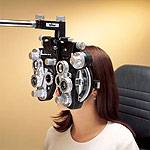 Glasses, contact lenses, and conventional LASIK all work by correcting a patient’s nearsightedness, farsightedness, or astigmatism using standardized, but not customized, lenses measured in units called diopters. The patient is asked to select the best “optically fitting” corrective lens by taking the “which is better – one or two?” test, called the “refraction.” In the same way, a shopper will try on different shoes until the best size is selected. Just as shoe sizes come in ½ size steps, glasses and contacts measurements come in 0.25 diopter steps. The best “off the shelf” lenses selected by the patient become the patient’s glasses or contacts prescription (just as the best “off the shelf” shoes will describe the shopper’s shoe size). Conventional LASIK simply places this uniform glasses or contacts prescription into the cornea using the laser beam. Because laser technology has become so advanced, conventional LASIK has become extremely successful at essentially replicating the glasses or contacts prescription in the cornea. However, conventional LASIK ultimately always is based on the “which is better one or two” refraction.
Glasses, contact lenses, and conventional LASIK all work by correcting a patient’s nearsightedness, farsightedness, or astigmatism using standardized, but not customized, lenses measured in units called diopters. The patient is asked to select the best “optically fitting” corrective lens by taking the “which is better – one or two?” test, called the “refraction.” In the same way, a shopper will try on different shoes until the best size is selected. Just as shoe sizes come in ½ size steps, glasses and contacts measurements come in 0.25 diopter steps. The best “off the shelf” lenses selected by the patient become the patient’s glasses or contacts prescription (just as the best “off the shelf” shoes will describe the shopper’s shoe size). Conventional LASIK simply places this uniform glasses or contacts prescription into the cornea using the laser beam. Because laser technology has become so advanced, conventional LASIK has become extremely successful at essentially replicating the glasses or contacts prescription in the cornea. However, conventional LASIK ultimately always is based on the “which is better one or two” refraction.
Customized Wavefront LASIK Measurements
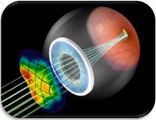 Customized wavefront LASIK is based on a different method for measuring your eye. Instead of using the “which is better one or two” refraction test, customized wavefront LASIK is based on measurements taken using an infra-red laser beam reflected through your eye. This infra-red laser beam is harmless and is invisible. It is shined into your eye and travels through the entire eye, to the retina which lies in the back of the eye. Once the infra-red laser beam hits the retina, it bounces back as a returning wave of infra-red light rays. Sensors measure how the front part of this infra-red wave of light rays moves through your whole eye, giving the system its name “wave-front.” Once the wave-front of reflected infra-red light rays leaves your eye, it will have been distorted by everything your eye, unique to you, does to light flowing through it. Sophisticated sensors map the distortions and micro-distortions your eye has uniquely produced in this wave of light traveling through your eye. This map is called your “optical fingerprint” because it is as unique to you, and as complex, as the fingerprint on your finger.
Customized wavefront LASIK is based on a different method for measuring your eye. Instead of using the “which is better one or two” refraction test, customized wavefront LASIK is based on measurements taken using an infra-red laser beam reflected through your eye. This infra-red laser beam is harmless and is invisible. It is shined into your eye and travels through the entire eye, to the retina which lies in the back of the eye. Once the infra-red laser beam hits the retina, it bounces back as a returning wave of infra-red light rays. Sensors measure how the front part of this infra-red wave of light rays moves through your whole eye, giving the system its name “wave-front.” Once the wave-front of reflected infra-red light rays leaves your eye, it will have been distorted by everything your eye, unique to you, does to light flowing through it. Sophisticated sensors map the distortions and micro-distortions your eye has uniquely produced in this wave of light traveling through your eye. This map is called your “optical fingerprint” because it is as unique to you, and as complex, as the fingerprint on your finger.
Wavefront technology allows us to measure and map your eye’s complicated optical fingerprint with instruments capable of 25 times the precision of conventional glasses or contacts measurements. Whereas glasses and contacts measurements use lenses measured in 0.25 diopter increments, sophisticated wavefront sensors are capable of working in 0.01 diopter increments. In fact, over 200 sensors, each capable of 0.01 diopter accuracy, are placed in front of the pupil to measure your the distortions in the returning infra-red light rays which determine your optical fingerprint.
Unique to You — Your Personal Optical Fingerprint
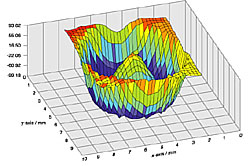 Each eye has its own unique complex optical distortions, or “optical fingerprint.” No two eyes have the same optical fingerprint — your optical fingerprint is as unique to you and as complex as your fingerprint on your finger. Simply correcting nearsightedness, farsightedness, and astigmatism by using standardized lenses measured in uniform 0.25 diopter increments does not perfectly correct this complex, irregular optical fingerprint — these “off the shelf” lenses only offer an approximate correction just like an off-the-shelf shoe may not give an exact fit. By contrast, Customized Wavefront LASIK (to use the shoe analogy further) is like placing your foot in a mold which will conform to its every nuance and curvature in order to make a customized pair of shoes which fit perfectly. Because wavefront treatments are customized to your eye, rather than being based on a subjectively chosen lens from the “which is better one or two” refraction, the results are more accurate and more specific to your eye’s needs.
Each eye has its own unique complex optical distortions, or “optical fingerprint.” No two eyes have the same optical fingerprint — your optical fingerprint is as unique to you and as complex as your fingerprint on your finger. Simply correcting nearsightedness, farsightedness, and astigmatism by using standardized lenses measured in uniform 0.25 diopter increments does not perfectly correct this complex, irregular optical fingerprint — these “off the shelf” lenses only offer an approximate correction just like an off-the-shelf shoe may not give an exact fit. By contrast, Customized Wavefront LASIK (to use the shoe analogy further) is like placing your foot in a mold which will conform to its every nuance and curvature in order to make a customized pair of shoes which fit perfectly. Because wavefront treatments are customized to your eye, rather than being based on a subjectively chosen lens from the “which is better one or two” refraction, the results are more accurate and more specific to your eye’s needs.
The three dimensional wavefront image, or “optical fingerprint” of the visual distortions and aberrations in a nearsighted patient’s eye. This complex computerized image is mapped for each patient and downloaded into the laser, which can replicate it in the cornea with billionth of an inch accuracy. This provides a level of precision and customization of treatment beyond that offered by glasses or contact lenses — or by conventional LASIK.
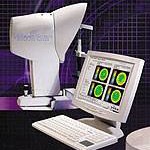 The VISX Wavescan is used by Dr. Shapiro to create the three dimensional map of the wavefront image, or “optical fingerprint” of your eye. An invisible infra-red laser is shined into the eye and over 200 sophisticated sensors map out the returning reflection of this laser from the back surface of the eye. To insure accuracy, four distinct wavefront maps are created within milliseconds and they are cross-checked to be sure they correlate with each other.
The VISX Wavescan is used by Dr. Shapiro to create the three dimensional map of the wavefront image, or “optical fingerprint” of your eye. An invisible infra-red laser is shined into the eye and over 200 sophisticated sensors map out the returning reflection of this laser from the back surface of the eye. To insure accuracy, four distinct wavefront maps are created within milliseconds and they are cross-checked to be sure they correlate with each other.
Customizing the Correction to Your Optical Fingerprint
This three dimensional map of your personal optical fingerprint is downloaded into the laser’s computer. Taking full advantage of the billionth of an inch accuracy of the eye-tracked, latest generation VISX S4 IR excimer laser, your optical fingerprint is sculpted directly into the cornea to create a truly custom tailored correction, regardless of any eye movement. Since glasses and contact lenses, and conventional LASIK, only correct nearsightedness, farsightedness, and astigmatism using standardized lenses measured in uniform 0.25 diopter steps, this is now the first time in medical history that we can actually strive to fully correct the eye’s entire optical system on a customized basis.
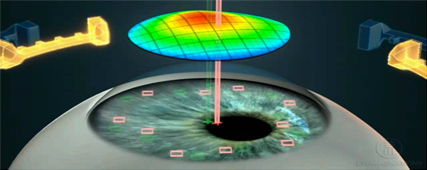 Since the time of its introduction in 2003, Customized Wavefront LASIK has evolved significantly. The first generation technology, or Zernike Wavefront, provided a high-resolution (detail of measurement) image of the optical fingerprint and provided the outstanding results seen in the FDA clinical trials mentioned above. A team in Silicon Valley later was able to improve on the Zernike math to radically improve resolution to create the ultra-high resolution second generation of Customized Wavefront technology, known as “Fourier Wavefront.” Third generation technology incorporates Fourier Wavefront resolution, but also incorporates sophisticated targeting and alignment systems using iris-registration from security systems technology to ensure more perfect alignment of the laser beam onto the cornea during treatment. This perfect placement is maintained on the eye during treatment by advanced three dimensional eye tracking systems based on missile tracking technology from military applications. Dr. Shapiro only uses third generation wavefront technology.
Since the time of its introduction in 2003, Customized Wavefront LASIK has evolved significantly. The first generation technology, or Zernike Wavefront, provided a high-resolution (detail of measurement) image of the optical fingerprint and provided the outstanding results seen in the FDA clinical trials mentioned above. A team in Silicon Valley later was able to improve on the Zernike math to radically improve resolution to create the ultra-high resolution second generation of Customized Wavefront technology, known as “Fourier Wavefront.” Third generation technology incorporates Fourier Wavefront resolution, but also incorporates sophisticated targeting and alignment systems using iris-registration from security systems technology to ensure more perfect alignment of the laser beam onto the cornea during treatment. This perfect placement is maintained on the eye during treatment by advanced three dimensional eye tracking systems based on missile tracking technology from military applications. Dr. Shapiro only uses third generation wavefront technology.
Thus, Customized Wavefront LASIK corrects vision with a precision and customization beyond that offered by glasses or contacts. Aberrations and distortions beyond nearsightedness, farsightedness, and astigmatism can now be corrected. This opens up the rather astonishing potential of vision superior to anything the patient has ever seen before. Customized wavefront LASIK is truly a breakthrough in vision correction and one that we are proud to be so deeply involved with at the Shapiro Laser Eye Center.
RESULTS
As with any surgery, results can never be guaranteed and there are risks to LASIK. However, as LASIK has continued to evolve into the most advanced form of Customized Wavefront LASIK incorporating Fourier wavefront reconstruction, iris registration systems, and three dimensional eye tracking, the results have correspondingly improved to previously unimaginable levels. Dr. Shapiro presented a landmark study of his techniques for Customized Wavefront LASIK at the annual international meeting of the Association for Research and Vision in Ophthalmology (ARVO) in Ft. Lauderdale, Florida. In this study 96% of his Customized Wavefront LASIK patients ended up with vision better than they had ever seen with glasses or contact lenses. The other 4% ended up with vision equal to their glasses or contacts. No patients in his study had vision worse than their glasses or contacts.
